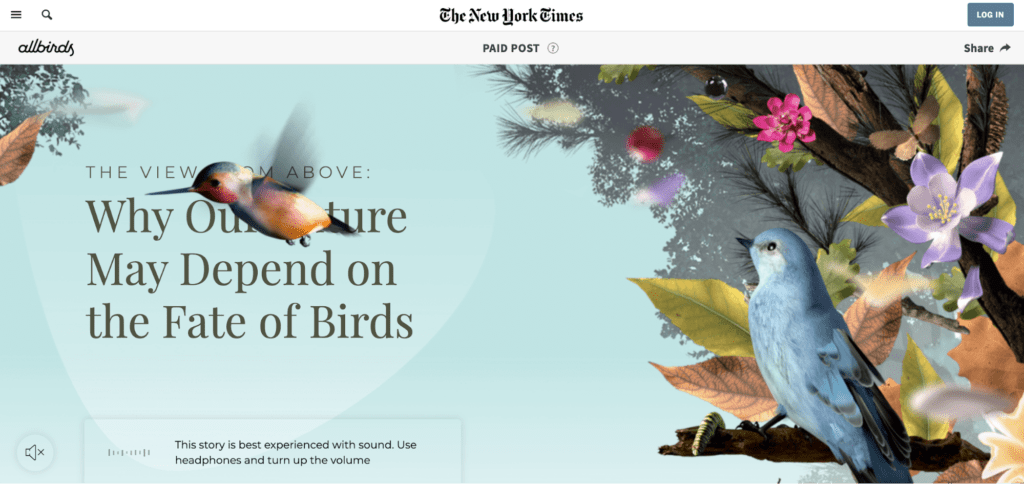
Blurred Lines: Putting the “Native” in “Native Advertising”
By Catherine Morgan
The other day as I was reading the New York Times, I stumbled across this beautifully designed article titled “The View from Above: Why Our Future May Depend on the Fate of Birds.”
The article seemed to have everything, from facts about specific birds’ lifespan and habitat to the impact they have on the environment and the way Allbirds shoes – the trending new trainers marketed for its sustainably sourced materials – are helping the environment.
Wait. What?
This wasn’t a feature story about birds and the future of our planet – it was a plug for Allbirds’ shoes. This was what is called “paid posts” or “sponsored content.”
This is native advertising. It’s advertising a brand through carefully curated prose. It appeals to the visual cues our brains are drawn to: image, color, font and movement.
As someone who has written sponsored content and is familiar with its quirks, even I was surprised at the length the New York Times’ T-Studio went to capture the audience’s attention as a feature story rather than a “paid post.”
The question is, how did they do it? How did they know it would work? How can you make it work?
Fitting in while standing out
I know what you’re thinking: “How can something fit in and stand out?” Aren’t those opposites?
Yes and no.
Let’s start with this: the New York Times understands consumers hate being sold something. Consumers prefer a story or image that captivates their senses over a banner or display ad that runs along the bottom of their screen.
In fact, most marketers only tap into about five percent of our conscious minds. The remaining 95 percent – the decision-making part of our brain, the limbic system – is unused.
This is where native advertising comes in. And this is how effective advertisers go about it.
Aesthetics and Design
If you look back at the Times’ article, you’ll see a flurry of colors and movement that create a cohesive narrative. It’s eye-catching. It’s captivating. It’s informative.
Effective native advertising will utilize elements of color, font, graphic design and creative writing to create a mental map for readers that leads them to the product. The goal is to tap into that 95 percent I mentioned earlier.
For more help, check out our graphic design and storytelling teams.
Metrics: Is this thing even on?
You can’t judge the effectiveness of your sponsored content if you can’t measure it. This means regularly analyzing your webpage’s click-through rates and conversion rates to monitor consumer engagement.
The baseline click-through rate for most banner ads is 0.05 percent whereas native ads can produce a CTR anywhere between 0.16 and 0.38 percent. As a result, native ads are often a soft sell to consumers which generates quality user traffic and ultimately increases engagement.
Conversion rates are a function of consumers who click on your advertisement with the size of the total audience. Conversion rates are extremely helpful for new businesses, as it provides an idea of consumer engagement.
Attention to Detail
It goes without saying that good writing is detail-oriented. The more you can add to a story or feature, the more engagement your post is likely to have. That being said, brevity is your friend. Don’t write something for the sake of writing – make sure it’s meaningful, informative and thought-provoking. For more tips on how to write strong copy, check out our blog post.
Much of advertising is appealing to the senses. While most of native advertising is digital, it doesn’t mean that you can’t get creative outside of the copy itself.
While some may feel a bit duped from the New York Times’ stellar native advertising ploys, you’ve got to admit it: they advertise with grace, style and imagination. And you can too.
Let’s start now. Contact us today so our Storytelling Team can take your brand to the next level.

